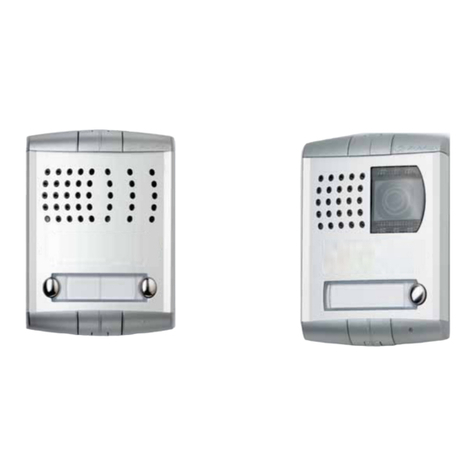
Increase the value in Location 118 to 250 (maximum 255) to start with, reset the Comfort PCB
and test. If necessary, reduce the value in Location 118 to lower the voume of telephone voice on
the Door Station. Always do a dial test after changing these locations to confirm that dialout
is not affected.
Door Station Programming
Location 1674 determines how many Door Stations are installed in the system. Enter valid values
0 or 1 and reset the system by pressing the Reset button on the Comfort PCB. When the Door
Station button is pressed, a chime is heard on the Door Station and keypads. In Home, Night and
Day Modes, the phones on the premises will ring if a Ringer Module is installed. In Away (and
Vacation) mode the system will dial to the programmed number according to the settings in Alarm
Type 25. A Doorbell Response may be programmed in Location 1691, which may be used for
switching cameras or other supplementary actions.
Door Station as Internal Intercom
The Door Station can be used as an intercom within the premises, by making it appear as a
Keypad. Set JP5 so that the Door Station is a Keypad. Set the ID switches in SW1 to select the
next available address for a Keypad. Program Location 1675 to correspond to the number of
Keypads in the system. Reset the Comfort panel. Pressing the Doorbell button will initiate the
Intercom mode just like pressing the F + 8 function key. The Doorbell button also switches
communications to talk mode when communications is established. However, this intercom
cannot terminate the Intercom Mode, as there is no F key. Intercom mode can be terminated by
the other Keypad or can be left to ‘time out’. .
After completion, disable Comfort’s RS485 data port KA-KB by setting Location 1672 to '0'
by entering Engineer Menu 7,4,1, then RESET. Comfort is always ready to receive data if
this flag is set, making the system vulnerable through theDoorphone.
Door Station Operation
In Security Off, press the Doorbell button. The Keypads will produce a door chime. If a ringer
board is connected, the house telephones will ring. Press any button on one of the Keypads. The
Keypad says
Press 0 for Door Station
Press 0. You can now talk to the Door Station. In this mode, only one side can talk at any time,
while the other side listens. The red MIC led on the Keypad and Door Station comes on when the
respective station is in Talk Mode. The Keypad controls the direction of the conversation by
pressing 1 to switch from talk to listen and vice versa. To end, press the F key. You can see the
red MIC led through the semi-translucent polycarbonate housing.
Press the Doorbell button again, but this time, use the local telephone to answer the chime. As
before, press 0 for Door Station. With the telephone, you can talk naturally with the Door Station
without having to press 1. Just hang up to end the conversation. Obviously, using the phone to
talk to the Door Station is preferable to the Keypad, but the Keypad may be closer than the
nearest telephone sometimes.
In Security Off, Day and Night modes, when people are at home, you can use the local phone or
Keypad to answer the Door Station
If more than 1 Door Station is installed, pressing 0 for Door Station will connect to the one where
the doorbell button was pressed. Pressing 1 to 3 will select the Door Station number directly.
6




























